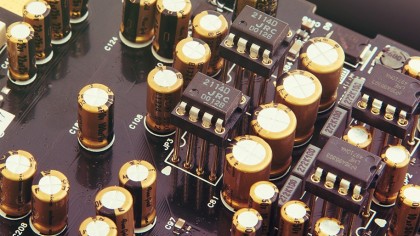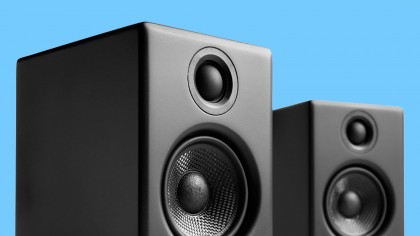
Go on any audio forum and you'll find a deluge of audio purists arguing the merits of lossless media, what the best headphones are that week and how your taste in music is the worst.
Sorting facts from opinions in this lawless land of FLACs and Ogg Vorbis files can be a headache so, in an effort to spread the purest aural information available, we went to one of the most preeminent headphone manufacturers in the world, Creative Labs (the makers of the Sound Blaster series of sound cards, Bluetooth speakers and headphones), to shed some light on audio's deepest, darkest questions.
(Editor's Note: The interview that follows was conducted at Creative's offices in San Jose, Calif. with four of the team's audio engineers and Creative product marketing manager, Ryan Schlieper. Per Creative's request for competitive purposes, we have not named the engineers.)
TechRadar: End the debate once and for all: Can the human ear hear a difference between a 16-bit 160Kbps "standard quality" OGG from Spotify and 24-bit 320Kbps FLAC file from Tidal?
Creative team: Yes, but you really need to do A-B testing, and of course it depends on what speakers you're using. It's much easier to tell when audio sounds bad or unnatural than distinguishing levels of clarity.
And it also depends on the source. If you have a 24-bit, 192KHz source of a symphony, you're going to hear a difference between that and 24-bit, 192KHz version of Green Day. Because of the dynamic range and the intermeshing of so many things, there are just more details that are needed on the symphony side. If you want a simple takeaway: Higher bitrates are more important than the sample rates.
TechRadar: So what is the physical limit of human hearing?
Sign up for breaking news, reviews, opinion, top tech deals, and more.
...you have people that like to project that they have more complex palates than they do because it makes them more sophisticated or justifies their purchases or whatever.
Creative team: Most young people's hearing cuts off at around 18KHz. Older people can only hear frequencies of up to 15KHz. It's very rare for people to be able to hear 20KHz directly.
Audio fidelity is like wine tasting, though. There are certainly people with more complex palates, but you have people that like to project that they have more complex palates than they do because it makes them more sophisticated or justifies their purchases or whatever.
At the end of the day there are audiophiles that really want a great reason to spend a lot of money on really high-end equipment that they want to brag about.

TechRadar: What are your thoughts on software that claims to have bass-boosting technology? Is it really doing anything special, or simply haphazardly increasing low-frequency sounds?
Trying to get higher quality sound on low-end headphones is like being a tourist in a foreign country.
Creative team: People don't understand that if you don't have a speaker that can't produce bass frequencies because it's too small [like, say, the pack-in earbuds that come with new cell phones], it doesn't matter how much you do to that sound file. You won't hear a difference.
Trying to get higher quality sound on low-end headphones is like being a tourist in a foreign country. If the waiter at a restaurant doesn't understand what you're saying, it doesn't matter how loud you say it.
TechRadar: Then what can you do to get lower frequencies?
Creative team: The human ear - or human ear-brain combination - can't hear strong frequencies if they're too close together. Those are the ones that are getting omitted in MP3s.
But if you look at the algorithm we use, we take the low-frequency input and we run it through a harmonics generator that uses natural harmonics to convince the brain that it's hearing loud low notes. We're synthesizing audio in a sense. We're amplifying and creating additional information that tricks your brain.

TechRadar: What's the most important thing to look for in a high-end pair of speakers?
Creative team: Look for something around the size of a bookshelf speaker. If it's smaller than a milk carton, it really won't work. There are physical limitations to what the lowest frequency that a certain size of speaker can reproduce unless it's a pressurized enclosure.
TechRadar: Why are headsets marketed as 5.1 or 7.1 surround sound? Plain and simple, two-channel systems can't be surround sound, right?
Creative team: So here's the thing, any headset that claims it's 7.1 surround sound is full of s***. There are headsets that have physically packed three drivers into an earcup, but they're crap. You can't do it that way ... the audio physics don't work out and we noted the speaker drivers actually work against each other in this configuration.
So here's the thing, any headset that claims it's 7.1 surround sound is full of s***.
That's why the psycho acoustic 7.1 headsets (headsets that are using algorithms to trick your brain) are vastly superior because we're virtualizing a surround experience in a stereo playback situation versus the impossible situation of having drivers millimeters apart simulating surround.
Here's what you can do: You can take the left and right channels in different amounts and there can be delays between them.
TechRadar: So, say an explosion happens to my left in game like Battlefront. My left ear will hear the loudest sound first followed by a smaller sound in my right ear a second later, right?
Creative team: Exactly. This tech isn't just about manipulating hardware. It's taking the hard-wired processes in the human brain and using math to get you to hear things in a convincing way. It's basically 3D for your ears.
For more features like this one, check out our interview with Strategic Partnership Manager at Tidal, Pål Bråtelund, interview with Tommy Tallarico or our inside look at Skywalker Sound.

Nick Pino is Managing Editor, TV and AV for TechRadar's sister site, Tom's Guide. Previously, he was the Senior Editor of Home Entertainment at TechRadar, covering TVs, headphones, speakers, video games, VR and streaming devices. He's also written for GamesRadar+, Official Xbox Magazine, PC Gamer and other outlets over the last decade, and he has a degree in computer science he's not using if anyone wants it.